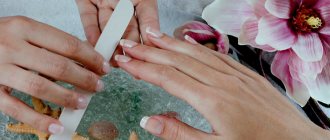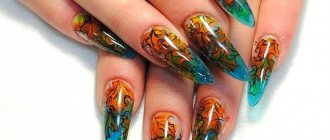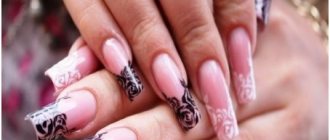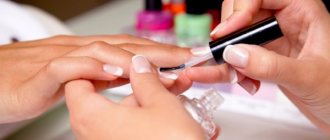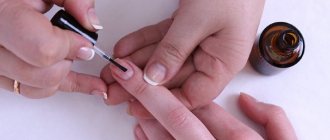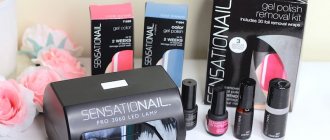The procedure of manicure and application of gel polish is quite popular today, which is why it is worth familiarizing yourself in detail with the products that are used in the process. Masters prefer acidic and acid-free primers, which prepare the nail plate for work. As a result, the question arises, which primer for gel polish is better: acidic or acid-free? In this article we will talk about all the features of these tools, and also answer frequently asked questions.
What is an acid-free primer?
An acid-free primer is a means for degreasing the nail plate, which is also used to increase the adhesion of the nail and the material. Thanks to this product, the final result is preserved for a longer time; the integrity of the coating is not distorted even with prolonged wear.
There are many advantages of an acid-free primer, we note:
- The nail plate is not susceptible to negative effects, even with prolonged walking;
- You can prevent the occurrence of peeling of the nail plate;
- A very convenient and affordable product to use;
- Durability.
Interesting! It is the acid-free primer that does not destroy the nail plate, but deeply degreases it, allowing the gel polish to lie perfectly evenly on the surface and be fixed for a long time.
The acid-free primer contains useful and safe components, which is why many people prefer it.
Scope of application of acid-free primer
Acid-free primer is used mainly at the time of coating nails with gel polish or during extensions. It is he who prepares the nail plate for the rough effects of the base coat, as well as for applying the product itself.
Experts do not recommend using a primer to create a home manicure without using gel polish or extension gel. For regular polish, the effect of the primer will not be 100% visible; the nails may still be brittle, not guaranteeing a tenacious bond between the nail plate and the polish.
Reviews
The most positive reviews were received by the middle price range - Kodi, Masura. Since the requirements for expensive products are higher, they, as a rule, did not live up to expectations. But if we talk about inexpensive products, then Runeil was considered the best among acid-free primers.
It is important to consider that many of the negative reviews were mainly due to the wrong combination of materials. Using even the best primer, you can get zero adhesion of the gel to the nail and vice versa. It all depends on the compatibility of brands. Therefore, such products are usually purchased in series. Also read reviews about the treatment of nail fungus with hydrogen peroxide.
What is an acid primer?
An acid primer is a nail strengthener that contains a small amount of methacrylic acid. These are quite toxic and poisonous substances that greatly dry out the nail, allowing good adhesion between the nail and the gel.
Important! The use of an acid primer is only appropriate if the nail plate is excessively oily. Its use is contraindicated for girls with a dry surface, as this can lead to excessive dryness.
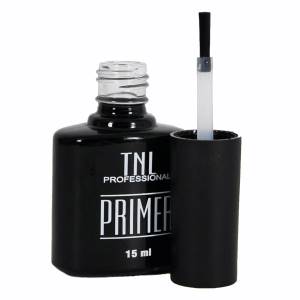
Many people are interested in the question of how to distinguish an acidic primer from an acid-free one? There is only one answer: you need to read the instructions provided in detail, as well as the ingredients. If the goal is to choose an acidic primer, it must contain acid, which will ensure complete drying of the nail plate.
What is acid primer used for?
The difference between acidic and acid-free primers is obvious, and the answer can be seen in the very name of the product. But what is the difference between an acidic primer and an acid-free one, and how does the scope of application depend on this?
As already described above, acid primers are appropriate to use only for girls whose nail plate is characterized by increased fat content, which resists the tenacious adhesion of gel polish and nails. The instant drying effect is visible on the face, because in a matter of seconds the nail plate is covered with a so-called film, which guarantees dryness and safety for the nail during exposure to the components of the gel polish or extension gel.
Terms of use
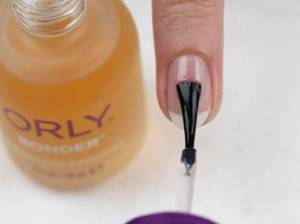
Usually there are detailed instructions on the bottle, but each manicurist uses it differently. As a rule, the primer is applied to the nail before applying the base. The cuticles and nails should already be prepared.
The acid-free composition requires preliminary degreasing. The product is applied without touching the cuticle and skin and slightly retreating from the edges. If the primer does get on your skin, you should immediately wash your hands.
The brush should sneak to the very center of the nail, and the primer will distribute itself over the surface. Only after this are smearing movements made. Before applying the composition, the brush must be carefully pressed against the edge of the bottle so that the layer is very thin.
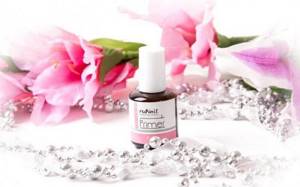
If the product is presented in the form of a gel, then in some cases it needs to be dried in a UV lamp. If this is not required, then air drying will still take longer than when using a liquid composition. Before using a new product that has not been used before, it is better to read the instructions.
Some primers form a sticky layer , similar to double-sided tape. They guarantee good adhesion of the coating, but dry for a very long time. They should be applied in as thin a layer as possible, and if after the recommended waiting time the product has not dried, you can blot off the excess with a lint-free napkin.
What is the difference between an acidic primer and an acid-free one?
Having learned that there are two types of primers, many people have a question: what is the difference between an acidic primer and an acid-free one, and which option is best to use in the process? The very first difference is the composition of the products, namely, the presence or absence of acid, which is responsible for additional instant drying of the nail plate.
In addition, other differences between acidic and acid-free primers can be noted:
- The acidic product is recommended for use only by girls who have extremely oily nail plates;
- The acid primer ensures strong adhesion of the material and the nail, as a result of which the gel polish lasts much longer;
- An acid primer is applied primarily under acrylic nails, but an acid-free primer is used for gel extensions;
- An acid-free primer is a universal product, it is suitable for any nail plate, it is recommended even for girls with weak and flaky nails, which cannot be said about an acid primer. Its purpose is exclusively to increase the oiliness of nails;
- An acid-free primer affects the surface only after the base color coat has been used and is not effective in its pure form.
Another simple way to determine which product is used during the manicure process: an acidic primer leaves behind a noticeably white tint after drying, but this is not observed after using an acid-free product.
Which primer is better: acidic or acid-free?
Due to their characteristics, acidic and acid-free primers are popular. Some products have more, others have less. Due to this, many are interested in which option is better before applying gel polishes, and which option should be preferred.

The choice will depend directly on the goal, which is why it is worth considering the features of the two options in more detail.
Acid primer:
- Used to treat damaged and brittle nails;
- Used before applying shellac, gel, acrylic;
- The composition contains methacrylic acid;
- Sometimes negative reactions of the nail plate may occur, which is why it requires a thin application to the nail;
- It is characterized by a pungent odor, so when using it you need to wear special masks on your face.
Acid-free primer:
- Suitable for use before applying gel polish, shellac or extensions;
- Just like acidic, it is used for damaged nails, providing them with density after application;
- There are no acids in the composition, only ethyl acetate is present;
- Dries quickly, has an unpleasant odor;
- It is gentle on any type of nails.
In most cases, experts prefer an acid-free primer, because it copes with all the necessary tasks, and is also ideal for every girl and does not cause allergic reactions.
Bond (teacher)
This primer is the basics. Its second name is bond. It is applied directly to the surface of the nails. The bond degreases and dehydrates the surface layer of nails without affecting the lower layers. This feature is a definite advantage, as it helps protect the nail from drying out and becoming brittle.
The bond does not contain flavoring additives or dyes. Due to this, its use will not harm people prone to allergic reactions.
As a rule, the bond is applied as a base for ultrabond. But its use under regular varnish also helps to extend the durability of the coating.
Bond is especially recommended for those who are prone to sweating. Since sweat causes artificial materials to peel off, the use of a pre-primer protects the coating. Therefore, regardless of what the master does (manicure or extensions), the use of bond will be an additional factor ensuring the durability of the coating.
How to apply primer correctly?
In order for a manicure primer to give the desired results, fully strengthen your nails and provide them with protection, you need to familiarize yourself with the features of its use. Acid and non-acid products have their own application rules, which is why you need to familiarize yourself with them in more detail at the beginning of the manipulation.
Acid primer
The differences between acidic and acid-free primers have already been clarified; they exist not only in the nature of the effect and composition, but also in the methods of application to the surface of the nail plate.
We must remember! The composition contains toxic acid, but it does not negatively affect the nail if you follow all the rules of use.
First you need to prepare your nails; a manicure with all procedures is done first, because after applying the product, any manipulation with a nail file or tweezers is prohibited.
You need to put a little product on the brush and touch it to the middle of the nail so that the primer spreads evenly to all corners. You should not take an excessive amount of liquid, which will flow outside the cuticle and only create inconvenience in use. If you take a small amount of the product, it will take the desired shape and allow you to dry it immediately.
The primer dries well under the influence of ambient heat and air, so 30-40 seconds is enough, and you can move on to the next step - applying the base coat, which is dried in a lamp.
Acid-free primer
The technology for using an acid-free primer is practically the same; first you need to prepare your nails for applying the product. Everyone considers an acid-free primer to be gentle, which is why many problems arise with it during use. Despite the fact that there is no acid in the composition, if there is an excessive amount it can harm the nail plate and dry it out. That is why you need to take the product onto the edge of the brush, and try to cover all 5 fingers of your hand with this minimum amount.
The primer does not leave any traces behind, which is why the nails take their original appearance in a few seconds and are considered ready for applying the base coat.
Subtleties when working with acidic and acid-free primers
Each nail primer has its own subtleties in operation, which you need to familiarize yourself with first.
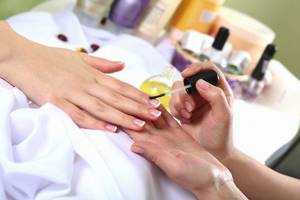
Both products are toxic substances that are present in the composition in greater or lesser quantities. That is why you need to know about the following important points when working with them:
- The master must wear gloves when working;
- You should not inhale the smell of the primer; it is better to use a special mask;
- Products are applied in a minimal amount and carefully distributed over the entire nail area;
- There is no need to dry them; they dry as quickly as possible even without a lamp.
These subtleties will allow you to carry out the work quickly, efficiently and effectively.
Important! If there are individual allergic reactions to the primer, its use should be replaced with other folk remedies.
Answers to questions from a manicurist
Every woman has a lot of questions when starting to work with an acid or acid-free primer. To get answers to all your questions, read below the answers of a specialist who knows all the intricacies and features of working with these tools, and also boasts extensive experience in this matter.
How to distinguish an acid primer from an acid-free one?
In fact, acidic and acid-free primers are two different products, the differences of which are visible to the naked eye. First of all, you need to familiarize yourself with its composition, and if the word “acid” is present in it, it is 100% only an acid primer. They also have different smells. For example, due to the acid content, an acid primer is characterized by a sharper odor, which not everyone can tolerate without a mask. This is a basic definition that can be noticed even before using it.
If you come to a specialist for a procedure and want to know which version of the product is used, monitor the condition of your nails after applying the primer. If it is acidic, then in a matter of seconds the nails will form a white color, which indicates that a full process of drying the nail plate has occurred. To learn about the difference between acidic and acid-free primers, watch the video:
What do acid and acid-free primers have in common?
Acid primers, just like acid-free primers, have their own characteristics, advantages, disadvantages, and similarities. Let's look at what is common and different between them. Example in the table.
| General qualities | Differences |
| Apply to nails to ensure tenacity of the nail plate and material. | Compound |
| They have a sharply unpleasant odor. | Price |
| There is no need to dry them in a lamp. | Nail color after application |
| Apply a light layer to the nails. | Women's category for use. |
| Does not cause allergies. | Level of impact on nails. |
Do you need a primer for regular nail polish?
Many people actually use primer for regular nail polish, and it gives good results. After applying the product, the nails become denser, do not become brittle, and the varnish itself lasts several days longer than without using it. But in most cases, a primer is necessary specifically for gel polish.
Is it possible to apply gel polish without primer?
If you do not use a primer for gel polish, the effect will be slightly different. The duration of the integrity of the gel will be minimal; nails may become brittle, chipped, or hit. Gel polish requires the use of a primer for greater density and integrity of the nails, which is why you need to take care of its availability in advance.
Price
How much does a primer cost? The price depends not so much on the type of product, but on the volume and brand of the manufacturer. Thus, the acid primer “Kodi” will cost 150 rubles for 10 ml, and the same product from the “Victory” brand will cost 300 rubles for 12 ml.
Many people believe that another primer will be cheaper. The price of an acid-free product is sometimes even higher. Thus, the “Naomi” product costs 180 rubles per bottle (12 ml), while “Gel Nail Prep Step 2” from an American manufacturer will cost at least 700 rubles (15 ml).


